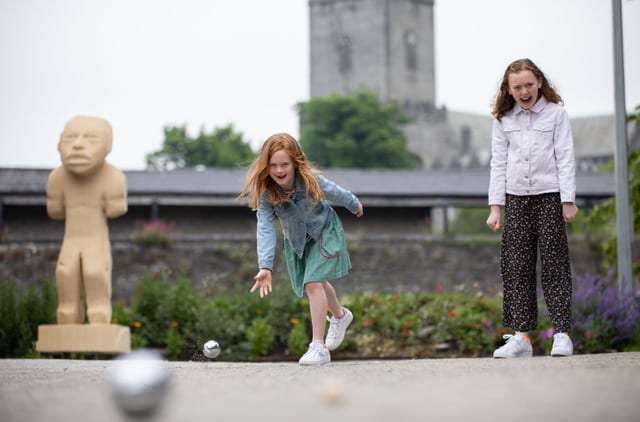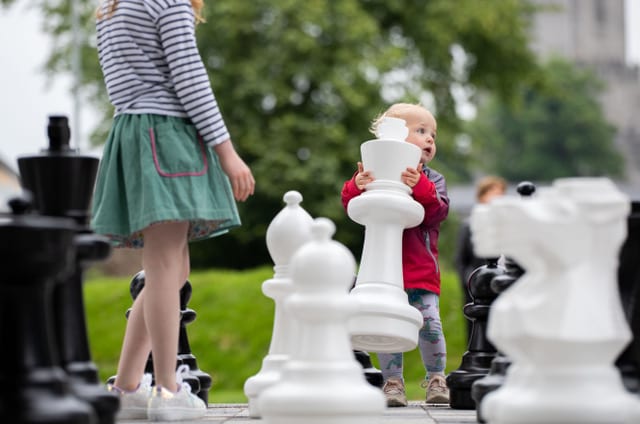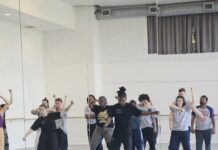

The Hunt Museum, which exhibits one of Ireland’s greatest private collections of Art and Antiquities, has created an exciting new public space for Limerick. Museum in a Garden takes the Hunt Museum outside its walls to create a public urban garden in the heart of Limerick. The concept behind the garden is to break down barriers to culture and art and encourage greater engagement with the community.
Enjoying the Giant Chess Board at the opening of the Museum in a Garden, Hunt Museum Limerick was 2 year old, Arina Kavinska, Ballysimon Road, Limerick. Picture Alan Place.
Last year, The Hunt removed the railings around its green space to create the Museum in a Garden. Conceived as an extension to the museum, the garden will feature seven super-sized sculptures replicating artefacts from the museum. First to be installed is Olmec Man, a Mexican artefact that was digitised by TY students and made into a two-metre outdoor replica using 3D printing technologies with help from ESB, Arup, the Limerick School of Art & Design (LSAD) and Monaru.ie. Picture: Alan Place
Good evening everyone. Can I echo Jill’s welcome to you all today to our new Museum in a Garden.
It is a great honour as Chair of the Museum to explain to you the how and the why of our lovely new public space.
Back in 2015, not so well known perhaps, we as a board were faced with a museum under threat of closure. It required digging deep to save it and boy, did our communities in Limerick dig deep.
Since those early tough board meetings, thousands of volunteer hours and over 1 million euros has been spent to make the building safe for our staff, for our visitors and our collection
But it was not just about the building. We wanted to exit the crisis by repositioning the Hunt in the social fabric of Limerick. We knew that required an ambition not just to be good but to be excellent!
Higher profile exhibitions, most notably the Paul Henry/Yeats exhibition of 2017, showed you did not need to travel to Dublin to see great works of art. Indeed the Dubliners came to Limerick instead.
As Limerick now becomes the Gateway city to the Wild Atlantic Way (and well done to the many here today who achieved that result), Naomi’s exhibition choice for this summer of Wild Atlantic Way paintings sets out the leading role the Hunt plans to play in that mission.
But 6 years ago, in our Annual Report, as Chair, I wrote: “Reflecting our desire to see the Hunt continuously enriched as a place of public enjoyment, during 2015 we commenced working with Limerick City and County Council to open the riverside garden to the public fostering a public sense of ownership of the museum facility and creating a first class public space in the grounds….”
It has been I have to admit, a pet project of mine, and I am so proud of the work of the Hunt team and the journey that has been travelled steadily since then over 6 years..
First, in 2016, we resolved insurance and security issues and made the decision to simply open the gates to tell people they were free to rediscover this long unloved space. The journey had started.
Next, despite no visibility of funding on the horizon, we agreed to forge ahead with the competition for a garden design. We believed that if we came up with a good enough design, we’d find ways to fund it somehow. It worked, thanks to the generosity of many of you here today.
Then, there was the fun and excitement of the day we judged the proposals of the school kids about what they believed the garden should be. Indeed, many of their ideas are visible here today.
Soon after, it was onto Covid zoom calls and the heavy responsibility our judging panel felt to choose a final design. Hopefully, you agree with us that Nicola’s design has so perfectly captured the magic of this riverside site for the decades to come.
The day though that I knew that there was no way back was the day we took down those (forgive me OPW) awful railings which walled off the museum from the walkways by the river. A physical barrier sending out for two decades a message of exclusion to so many who should instead have been regular visitors to our Museum. My dad, the real builder in our family, would have laughed at the video of me using the angle grinder – and still not using it properly!
This past year, we recall the struggles to fund raise through COVID lockdowns, the challenges of construction during the same restrictions, the disappointment of having to saying goodbye to our lovely Horse Chestnut tree but most of all Jill’s determination that this garden project would be open for summer 2021 as we all begin to find our new normality.
Like a metaphor for what now needs to happen in our little country, with this garden the Museum is building back better. We do that with an increased appreciation of the value of community. We do that with a new understanding of the value of outdoor spaces and amenity. But mostly we do that with a sadness for those who have passed during COVID times. We hope this little oasis of reflection will become a special place of remembrance to help those denied the opportunity to grieve and bid farewell to loved ones in the normal way.
But we are not finished yet. The plants have to mature and more installations have yet to be added.
And as you wander the garden today, as a hint of our next chapter and ambition, please walk the new carefully positioned central pathway in the direction of the building and look forward with me to the day (we hope not too far in the future) when the entrance to the Museum can once more be through the fine portico which was the entranceway chosen by Italian architect Davis Ducart when he designed this majestic building in the mid-18th century for Limerick.
But today we take already a big step forward. We now have a garden built by our community for our community.
Badly designed, badly managed public spaces, like we had before, are likely to be located in the more deprived inner urban areas of our cities. But that is exactly where we most need to provide quality liveability space and cultural curiosity to combat any sense of daily despair or lack of belonging.
Poor spaces also send a terrible message to visitors and reduce a city’s own sense of personal pride and esteem.
Well designed public spaces by contrast do just the opposite.
They lift our moods. They inspire us to do better. They create those little moments for a daily smile.
I hope that the project we unveil today continues to inspire the welcome recent trend of improving public realm in Limerick.
Public spaces should be open forums for ALL residents, bringing communities together, those living in happier times and those struggling to get by. They are what make the place one lives into a home.
Good public spaces should be accessible and open to all with no barrier to entry. Above all, we want OUR garden to be for ALL communities.
Combined with important civic amenities like the Museum, great public spaces ensure tightly knit communities where no one needs to feel lonely, where no one fears the night approaching and where no one has to cope alone with life’s struggles.
I believe Limerick, whose river knows only too acutely the tragic consequences of mental health issues, must now place a premium on developing more of these community spaces. It is that belief that made it such a pleasure for our family to be able to support the construction of the community garden to remind us of my Dad, the ultimate Limerick builder and lover of this river.
Today, in this new waterfront public space for Limerick, we celebrate the work of the many volunteers marshalled by our own Linda Hall, we thank the generosity of so many funders, but most of all we acknowledge the innovation and tenacity and never say no spirit of our director Jill Cousins and her predecessor Naomi O’Nolan. Together, over six years, they navigated the many obstacles to this reality and without them we would not have this amazing garden.
Jill will provide more detail soon but on behalf of the Hunt board, I thank all of you and our own team so sincerely.
In concluding, I would like to leave you with a quote from one of my inspirations, the great urban designer, Jan Gehl from Copenhagen,:-
Let our Museum in the Garden become the place where people stay longer than necessary.
With our Museum in a Garden, we now tell the world, we are a people proud of our riverside location, proud of our heritage and proud to be able to share our home with ALL strangers.
“A good city is like a good party – people stay longer than really necessary because they are enjoying themselves.”
Mile Buiochas for your presence, your support and for your attention.
John Moran









